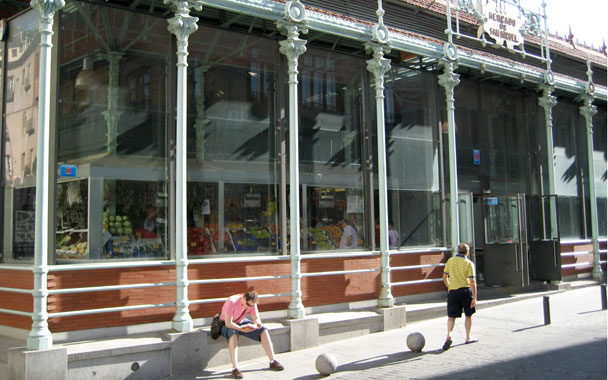For the better part of the 20th century, Madrid’s San Miguel market was the centerpiece of the Plaza Mayor neighborhood, its 75 stalls providing local cooks with pretty much anything they could want. Today, though, while its wrought-iron and glass exterior remains intact, there’s nothing but rubble and dust inside.
Over the past five years, as the market began to languish—many of its original stalls emptied by retirements, deaths, and the onslaught of suburban supermarket chains—a group of businesspeople and gastronomes began buying up the leases. By the end of last year, just one homely sign—black marker scrawled on white poster board—clung to a corner of the construction site. “Fishmonger and Fruit Stand,” it read; “we’re in back.” José Bonales and Joaquín Nieves, the men behind the sign, had been renting space at the market for decades, and neither one was inclined to give up his business. Eventually they were forced out by judicial order, and today they are appealing their removal in court.
Once the renovations are complete (probably in the fall), the San Miguel will re-open as “a center of gastronomic recreation,” according to Curra Fernández, spokesperson for Gastrodomo de San Miguel, the group behind the transformation. Thirty stalls will sell upscale seasonal produce, cheese, fish, and meat; and the market will also house a handful of carts offering tastings; a newsstand specializing in culinary magazines; cooking demonstrations; an “international” stall selling prepared food; and a TV station turning out food-related programming. “We want to turn this into an internationally recognized culinary center,” says Fernández.
Whether Bonales and Nieves have a right to remain in the re-imagined San Miguel is a question the judges will have to sort out. Harder to answer is whether it will be possible to create a market that is both tourist attraction and neighborhood standby. Barcelona’s Boqueria would seem to suggest that it is, but the Boqueria emerged organically, over time—it wasn’t a wholesale, start-from-scratch creation. (And even so, plenty of longtime Barcelona residents look at what their market has become—the smoothies! the shrink-wrapped dragon fruit!—and lament its transformation.) The San Miguel “is not just for tourists,” emphasizes Fernández. “A tourist isn’t going to buy a whole hake.”
She has a point. But Amelia Araguza, who is just the sort of person who does buy a whole hake, still has her doubts. The 50-something housewife grew up in the neighborhood, but on a recent Saturday morning, construction at the San Miguel had forced her to shop elsewhere. “I’ve been going to those fishmongers and butchers all my life,” she says, “but I don’t know if I’ll go back when they re-open. It all depends on the prices.”




 Pinterest
Pinterest


